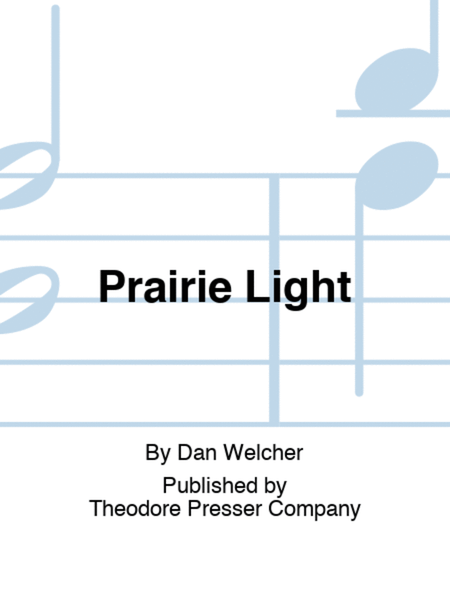Prairie Light
Three Texas Watercolors of Georgia O'Keeffe
-
Ships in 1 to 2 weeks
Details
Description
SKU: PR.11640366S
Three Texas Watercolors of Georgia O'Keeffe. Composed by Dan Welcher. Full score. 64 pages. Duration 14 minutes. Theodore Presser Company #116-40366S. Published by Theodore Presser Company (PR.11640366S).Dan Welcher’s most enduringly and frequently played orchestral work, Prairie Light is a fascinating musical companion to three of Georgia O’Keeffe’s most unusual paintings, Light Coming on the Plains, Canyon with Crows, and Starlight Night. This work is ideal for performances using visual projections of the paintings, and is frequently programmed for subscription concerts as well as those for educational settings. Duration: 14’ Parts available on rental.
This work for full orchestra was inspired by three paintings of the noted Americanartist Georgia O’Keeffe. These three watercolors were done in 1917 while the artist was living in Canyon, Texas (near Amarillo), and deal primarily with color and shape. Consequently, the music is primarily concerned with broad lines and shapes rather than rhythms, with subtle washes of color rather than constant harmonic movement, and with arching melody instead of linear counterpoint.The first movement, Light Coming on the Plains, is an elliptical-shaped painting, deep blue to indigo with a “horizon” at the bottom that seems flat and unchanging. The sun hasn’t risen yet, although it does in the course of this movement, but it seems instead to be providing light from behind the canvas. The music is unmoving in terms of rhythm or harmony (although there is a modulation midway through), a color-infused mantra of sound that is almost Eastern.At the height of the sun, we proceed to the second movement, entitled Canyon with Crows. The canyon is red-orange, with black crows circling above friendly unfolding hills. The music is gentle but lively and more rhythmic, with the birds represented by solo oboe, clarinet, and sometimes flute. Halfway through, the brass have a chorale version of the opening motive, played very slowly, over the unending triplets of woodwinds and strings. At the end of the movement, the birds return for a duo-cadenza, accompanied by the dying rays of the sun in muted strings and the ongoing triplets of the solo quartet.The stage is set for the final movement, Starlight Night. In O’Keeffe’s painting, the stars are represented by regularly-spaced rectangles of bright pale yellow on a blue-black sky, with the same shape to the field of vision and the horizon that is found in Light Coming on the Plains. The stars become audible: harp, celesta, glockenspiel, and string pizzicati all lend a sparkle while a solo flute introduces a slowly unfolding theme. After this theme has been heard twice and the sky has begun to really brighten, there is a sudden interruption: a xylophone and a piano begin another “mantra” in brittle staccato chords. This is the same mechanical eternity as O’Keeffe’s regularly-spaced square stars, and it continues on its own as the night progresses. The music builds and grows as the moon rises and arcs, then falls as the pre-dawn light that opened the work returns to bring it to a close. Acycle of light, changing with the movements of sun, moon, and stars, appearing differently from various points of view.
Song List (3)
- I. Light Coming On The Plains
- II. Canyon With Crows
- III. Starlight Night

 Share
Share